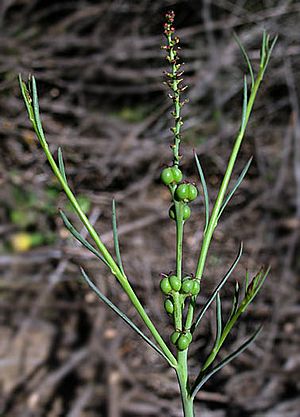Stillingia linearifolia facts for kids
Quick facts for kids Stillingia linearifolia |
|
|---|---|
 |
|
| Scientific classification | |
| Genus: |
Stillingia
|
| Species: |
linearifolia
|
The Stillingia linearifolia is a type of flowering plant. It belongs to the euphorb family and is also known as queen's-root. This plant grows naturally in the Southwestern United States, Southern California, and parts of Northwestern Mexico. You can find it in dry places like deserts, mountains, foothills, and areas with chaparral plants.
Discovering the Queen's-Root Plant
The queen's-root is a special plant that grows year after year. It is not an annual plant that dies after one season. It grows in a clump, sending up thin, straight stems that can reach almost 70 centimeters tall. That's about the height of a small dog!
What Does This Plant Look Like?
The leaves of the Stillingia linearifolia are long and skinny. They are arranged one after another along the stem. Each leaf can be up to 4 centimeters long, but they are very narrow, less than 2 millimeters wide. Imagine a tiny, thin green ribbon!
How Does the Queen's-Root Flower?
The flowers of the queen's-root grow on a tall, straight stalk called an inflorescence. This stalk is only a few centimeters long. What's interesting is that this plant has both male and female flowers on the same stalk. This is called being monoecious.
- The male flowers are found at the very top of the stalk.
- The female flowers, which will later grow fruit, are found below the male flowers.
Neither the male nor the female flowers have petals. After the female flower is pollinated, its ovary grows into a small, green, three-part fruit. This fruit is shaped like a tiny capsule, about 3 to 4 millimeters wide. Inside each of the three parts of the fruit, there is one tiny black seed.

